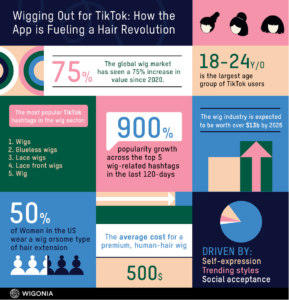The wig industry is experiencing an unprecedented boom, with sales reaching their highest point ever recorded. New data reveals a dramatic increase in wig purchases, indicating a significant shift in how consumers approach hair care and style. This surge in popularity is largely attributed to the influence of social media platforms, particularly TikTok, which has become a driving force behind the growing acceptance and desirability of wigs.
The global wig market, now valued at an impressive $10 billion, is projected to reach over $13 billion by 2026. This remarkable growth trajectory is the result of a perfect storm of factors, with social media visibility playing a crucial role in reshaping perceptions and driving demand.
Social Media: The Catalyst for Change
At the forefront of this transformation is TikTok, the short-form video platform that has taken the world by storm. On TikTok alone, wig-related hashtags have seen an astounding average growth of 900% in popularity over the last 120 days. This surge in visibility has had a profound impact on consumer awareness and interest in wigs.
Julia North, wig expert at Wigonia, explains: “Wigs are becoming more popular than ever thanks to the promotion of hairstyle individuality on TikTok. Younger people are experimenting with their personal style like never before, and if this trend continues, the wig industry will continue to see meteoric highs.”
The platform’s algorithm, which quickly identifies and promotes trending content, has allowed wig-related videos to reach millions of viewers. From tutorials on how to apply and style wigs to before-and-after transformations, TikTok has become a virtual playground for wig enthusiasts and curious newcomers alike.
Keyword Analysis: A Digital Pulse on Wig Popularity
An analysis of TikTok’s keyword trends provides valuable insights into the growing interest in wigs. The term “wigs” has seen a 114.81% increase in popularity over the past 120 days, with 5,000 shares. Even more impressive is the surge in interest for specific types of wigs:
- “Glueless wigs” experienced a 150% increase in popularity, with 25,000 shares.
- “Lace wigs” saw a staggering 620% growth, accumulating 2,000 shares.
- “Lace front wigs” witnessed an explosive 3,600% increase, albeit with a more modest 1,000 shares.
These numbers not only reflect the growing interest in wigs but also indicate a more nuanced understanding of wig types and application methods among consumers.

Infographic 1: This infographic combines data from TikTok advertising research dashboard and Statista.
Factors Driving the Wig Revolution
While social media visibility has been a significant catalyst, several other factors have contributed to the wig market’s explosive growth:
- Growing Awareness and Acceptance: Wigs are shedding their outdated image and are now embraced as a versatile tool for self-expression. They offer a convenient way to experiment with different styles, colors, and lengths without commitment, appealing to a generation that values flexibility and self-expression.
- Focus on Hair Health: More people are prioritizing the health of their natural hair, opting for wigs as a protective style that minimizes heat damage and breakage. This trend aligns with the broader movement towards self-care and holistic wellness.
- Rising Demand for High-Quality Options: Advancements in wig technology have led to more realistic, comfortable, and durable options, catering to a wider range of needs and preferences. These improvements have helped to dispel negative stereotypes associated with wigs and have attracted a more diverse customer base.
- Celebrity Influence: Many celebrities, like Sabrina Carpenter, and influencers have openly embraced wigs, further normalizing their use and showcasing their versatility. This high-profile endorsement has helped to position wigs as a fashionable accessory rather than a necessity.
- Cultural Shift: There’s been a growing appreciation for diverse beauty standards and hairstyles, which has created a more inclusive environment for wig wearers of all backgrounds.
The Future of the Wig Market
As the wig industry continues to evolve, experts predict sustained growth in the coming years. The projected increase from $10 billion in 2024 to over $13 billion by 2026 represents a 30% growth in just two years, a testament to the market’s robust potential.
This growth is expected to be accompanied by further innovations in wig technology, including more breathable materials, improved application methods, and even smart wigs that can change color or style with the touch of a button.
Moreover, the increasing acceptance of wigs may lead to their integration into other industries, such as fashion, health care, and even technology. We might see collaborations between wig manufacturers and fashion houses, or the development of medical wigs designed to address specific health concerns.
Conclusion
The unprecedented growth in the wig market, fueled by the power of social media platforms like TikTok, represents a significant shift in consumer behavior and societal norms. As wigs continue to shed their stigma and gain popularity as a tool for self-expression and style experimentation, the industry is poised for continued expansion and innovation.
This trend not only reflects changing attitudes towards personal style but also highlights the profound impact that social media can have on consumer markets. As we move forward, it will be fascinating to see how the relationship between digital platforms and the wig industry continues to evolve, potentially reshaping our understanding of beauty, self-expression, and personal style in the process.
Methodology: This press release analyzes the impact of TikTok trends on the global wig market, utilizing data from TikTok Keyword Insights and a Statista report titled ‘Forecast market value of hair wigs and extensions worldwide from 2020 to 2026.’ Our analysis of keywords like ‘wig’ revealed a 114.81% surge in search volume from June 2024 and October 2024, indicating a strong correlation with the projected 32% growth in the global wig market value, reaching $13.26b by 2026 (Statista).

